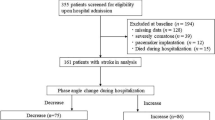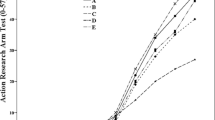Abstract
Background and aims
To address the relationships among motor patterns evaluated according to the limb synergies and functional outcomes in stroke patients and clarify which motor pattern was the most important predictor of functional outcomes.
Methods
The study was conducted on 208 patients with primary diagnosis of stroke admitted for in-hospital rehabilitation. At entry, the Fugl-Meyer Scale was administered to assess motor function according to limb synergies. Pearson’s correlation was used to assess the relationship between variables, and backward stepwise regression analysis was used to identify the outcome determinants. Final functional independence measure (FIM) scores and length of in-hospital stay were the outcome measures.
Results
At the end of rehabilitation, motor-FIM scores of patients with extensor and flexor synergies, mixing synergies, and no dependence from the synergies were higher than those of no movements and flexor synergy. Multivariate regression analysis showed that extensor synergy of upper limb was an independent predictor of final motor-FIM, personal care and mobility, extensor synergy of lower limb of locomotion, while mixing synergies of upper limb was an independent predictor of length of in-hospital stay.
Conclusions
In stroke rehabilitation, the patients’ motor patterns according to the synergies strongly relate with functional outcomes and are important outcome predictors.

Similar content being viewed by others
References
Shelton FD, Volpe BT, Reding M (2001) Motor impairment as a predictor of functional recovery and guide to rehabilitation treatment after stroke. Neurorehabil Neural Repair 15:229–237
Duncan PW, Min Lai S, Keighley J (2000) Defining post-stroke recovery: implications for design and interpretation of drug trials. Neuropharmacology 39:835–841
Twitchell TE (1951) The restoration of motor function following hemiplegia in man. Brain 74:443–480
Li KY, Lin KC, Wang TN, Wu CY, Huang YH, Ouyang P (2012) Ability of three motor measures to predict functional outcomes reported by stroke patients after rehabilitation. NeuroRehabilitation 30:267–275
Massie CL, Fritz S, Malcolm MP (2011) Elbow extension predicts motor impairment and performance after stroke. Rehabil Res Pract 2011:381978
Katrak P, Bowring G, Conroy P, Chilvers M, Poulos R, McNeil D (1998) Predicting upper limb recovery after stroke: the place of early shoulder and hand movement. Arch Phys Med Rehabil 79:758–761
Nijland RH, van Wegen EE, Harmeling-van der Wel BC, Kwakkel G (2010) Presence of finger extension and shoulder abduction within 72 hours after stroke predicts functional recovery: early prediction of functional outcome after stroke: the EPOS cohort study. Stroke 41:745–750
Welmer AK, Holmqvist LW, Sommerfeld DK (2006) Hemiplegic limb synergies in stroke patients. Am J Phys Med Rehabil 85:112–119
Pandian S, Arya KN (2012) Pandiani relation between the upper extremity synergistic movement components and its implication for motor recovery in poststroke hemiparesis. Top Stroke Rehabil 19:545–555
Brunnström S (1970) Movement Therapy in Hemiplegia: a neuropsychological approach. Harper and Row, New York
Dipietro L, Krebs HI, Fasoli SE, Volpe BT, Stein J, Bever C, Hogan N (2007) Changing motor synergies in chronic stroke. J Neurophysiol 98:757–768
Hartman-Maier A, Soroker N, Ring H, Katz N (2002) Awareness of deficits in stroke rehabilitation. J Rehabil Med 34:158–164
Fugl-Meyer AR (1980) Post-stroke hemiplegia assessment of physical properties. Scand J Rehabil Med Suppl 7:85–93
Luzzati C, Wilmes K, De Bleser R (1991) Aachener Aphasie Test (AAT). Organizzazioni Speciali, Firenze
Fullerton KJ, McSherry RW (1986) Albert’s test: a neglected test of perceptual neglect. Lancet 1:430–432
Bisiach E, Vallar G, Perani D, Papagno C, Berti A (1986) Unawareness of disease following lesions of the right hemisphere: anosognosia of hemiplegia and anosognosia for hemianopsia. Neuropsychologia 24:471–482
Parmelee PA, Thuras PD, Katz IR, Lawton MP (1995) Validation of the cumulative illness rating scale in a geriatric residential population. J Am Geriatr Soc 43:130–137
Brott T, Adams HP, Olinger CP et al (1989) Measurements of acute cerebral infarction: a clinical examination scale. Stroke 20:864–870
Collin C, Wade D (1990) Assessing motor impairment after stroke: a pilot reliability study. J Neurol Neurosurg Psychiatry 53:576–579
Granger CV, Cotter AC, Hamilton BB, Fiedler RC (1993) Functional assessment: a study of persons after stroke. Arch Phys Med Rehabil 74:133–138
Adler A (1964) The Bobath method in the treatment of cerebral palsy. Harefuah 66:62–63
Wee JYM, Hopman WM (2005) Stroke impairment predictors of discharge destination in stroke rehabilitation. Am J Phys Med Rehabil 84:604–612
Denti L, Agosti M, Franceschini M (2008) Outcome predictors of rehabilitation for first stroke in the elderly. Eur J Phys Rehabil Med 44:3–11
Chang JJ, Sung YT, Lin YT (1990) The relationship between early motor stage and hand function recovery six months after stroke. Gaoxiong Yi Xue Ke Xue Za Zhi 6:38–44
Kawahira K, Shimodozono M, Etoh S, Kamada K, Noma T, Tanaka N (2010) Effects of intensive repetition of a new facilitation technique on motor functional recovery of the hemiplegic upper limb and hand. Brain Inj 24:1202–1213
Hsu AL, Tang PF, Jan MH (2003) Analysis of impairments influencing gait velocity and asymmetry of hemiplegic patients after mild to moderate stroke. Arch Phys Med Rehabil 84:1185–1193
Bohannon RW (2007) Knee extension strength and body weight determine sit-to-stand independence after stroke. Physiother Theory Pract 23:291–297
Bohannon RW, Andrews AW (1990) Correlation of knee extensor muscle torque and spasticity with gait speed in patients with stroke. Arch Phys Med Rehabil 71:330–333
Saunders DH, Greig CA, Young A, Mead GE (2008) Association of activity limitations and lower-limb explosive extensor power in ambulatory people with stroke. Arch Phys Med Rehabil 89:677–683
Gialanella B, Prometti P (2009) Rehabilitation length of stay in patients suffering from aphasia after stroke. Top Stroke Rehabil 16:437–444
McClure JA, Salter K, Meyer M, Foley N, Kruger H, Teasell R (2011) Predicting length of stay in patients admitted to stroke rehabilitation with high levels of functional independence. Disabil Rehabil 33:2356–2361
Franchignoni FP, Tesio L, Ricupero C, Martino MT (1997) Trunk control test as an early predictor of stroke rehabilitation outcome. Stroke 28:1382–1385
Duarte E, Marco E, Muniesa JM, Belmonte R, Diaz P, Tejero M, Escalada F (2002) Trunk control test as a functional predictor in stroke patients. J Rehabil Med 34:267–272
Acknowledgments
The authors thank Dr Laura Comini for the critical revision and editing of the manuscript. The research was not supported by Pharmaceutical Companies. The research was supported by institutional funding.
Conflict of interest
The authors declare that they have no conflict of interest.
Ethical standards
The Ethics Committee of our Institution approved the study protocol and informed consent and all patients gave their written informed consent to participate. The study was conducted in accordance with the principles of the Declaration of Helsinki.
Author information
Authors and Affiliations
Corresponding author
Rights and permissions
About this article
Cite this article
Gialanella, B., Santoro, R. Prediction of functional outcomes in stroke patients: the role of motor patterns according to limb synergies. Aging Clin Exp Res 27, 637–645 (2015). https://doi.org/10.1007/s40520-015-0322-7
Received:
Accepted:
Published:
Issue Date:
DOI: https://doi.org/10.1007/s40520-015-0322-7




